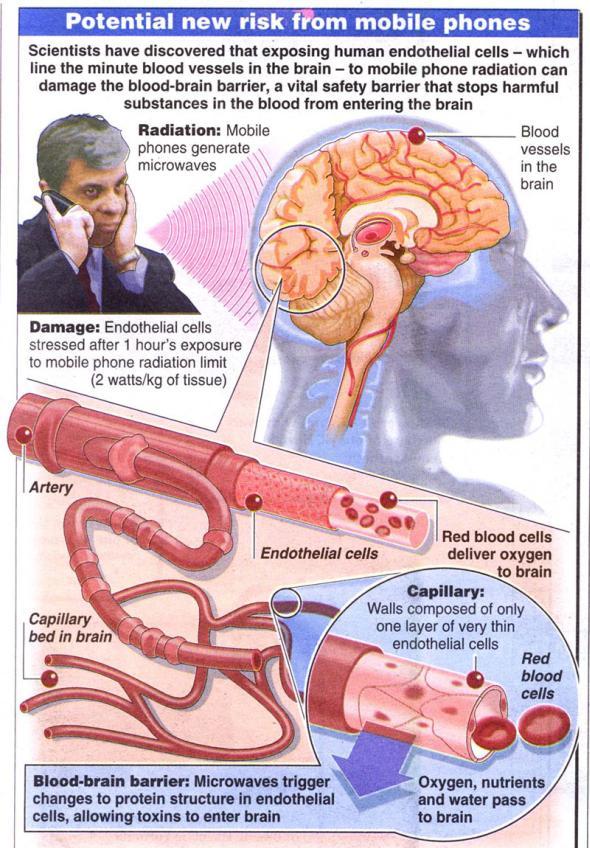The objective of the Interphone study was to determine if cell phone use increased the risk of tumor growth, specifically if RF energy is tumoregenic, and focused on four types of tumors; tumors of the brain; glioma and meningioma, acoustic nerve; schwannoma and parotid gland.
The study took place in 13 countries and involved 16 study centers. There were 2708 glioma and 2409 meningioma cases and matched controls. The majority of subjects in the study were not heavy mobile users with median lifetime cumulative usage about 75 hrs to 100 hrs.
Although the odds ratio was higher for heavy users in meningioma and glioma; temporal lobe tumors, the results of the study were deemed inconclusive as many factors were hard to determine; such as call volume and length, exact numbers were unavailable and were approximated based on user recall. The study also truncated call usage that was reported to be greater than five hours per day in usage, and more than 1640 cumulative hours of usage (4.5 hours per day for 1 year, 2.25 hrs for 2 years, and 1.5 hrs per day for 3 years).
Cell phone radiation can be damaging to human health.
Cell phone radiation can be harmful to human health. Users need to be informed of the risk from over exposures and protective measures. Neurological studies provide evidence of headaches, lack of concentration, memory loss and sleeping disorders. The studies have prompted World Health Organization (WHO) to announce results of a decade long study regarding cell phone usage; the study, known as Interphone, includes data from 12 different countries and provides evidence that after 10 years of use, there is an 18% increase of brain tumors on the side of the head where the cell phone is used the most often. Phone call should be controlled and restricted to a maximum of six minutes, which is the amount of time the body needs to adjust. Cell phones should not be carried on the body even on stand-by. A British study found that cell phones may harm sperm quality in a different way; storage of cell phones close to the testes had a significant negative impact on the sperm concentration and percentage of motile sperm. Men should avoid carrying their mobile device in pockets or on belt clips to prevent/minimize exposures to electromagnetic radiation.
http://www.w-cellphones.com/category/cell-phone-electromagnetic-radiation/
http://www.emfnews.org/articles/cell-phone-radiation/
http://www.emfnews.org/articles/tag/bluetube-headset/page/6/
Infertility and cellphone radiation.
In the last decade there has been an increase of mobile phone use and with this increase there is a growing increase about the possible side effects of cell phone use. There are studies that have been done that show the possible side effects causing cancer, Alzheimer’s and adversely affecting all body cells. There has now been research done by a team of professionals that have uncovered new research
that shows that prolonged cell phone use by males may cause infertility.
Studies of shown that using a cell phone 1 hour a day can adversely affect the sperm count in males. Researchers tested rat testis from a 26 days to 52 days and the rats that were exposes for 52 days 1 hour a day showed signs of necrotic changes, interstitial oedema, and atrophy of seminiferous tubules and the disappearance of the germinal epithelium of tubules. Researches then went on to evaluate the quality of semen of 13 men. All of these men had normal semen analysis according to the WHO criteria. Cell phones were not carried or used by any of these men in the first 5 days of the study and a semen analysis. The men then carried cell phones for a four week period on a phone belt and were used for 6 hours and 5 days a week. The semen parameters were compared and the results showed progressive spermatozoa were significantly reduced compared to the first study with no cell phone use.
In conclusion there is evidence that prolonged cell phone use can be detrimental to the human male and fertility. The studies that were done showed that there is a wide spectrum of possible side effects of cell phone use. The health care team that did the studies realize that more testing needs to be performed but with the data that they have is useful for further research and will help with giving the male population to be aware there is consequences to prolonged cell phone use.
Cell phone users have an increased risk of malignant gliomas.
The debate regarding the health effects of low-intensity electromagnetic radiation from sources such as power lines, base stations, and cell phones has recently been revisited. In this article, the authors attempt to address the following question: is there epidemiologic evidence for an association between long-term cell phone usage and the risk of developing a brain tumor? Included with this meta-analysis of the long-term epidemiologic data are a brief overview of cell phone technology and discussion of laboratory data, biological mechanisms, and brain tumor incidence.
Khundi, M, Khurana, V, Hardell, L, Carlberg, M, & Vini, T. (2009). cell phones and brain tumors: a review including the long-term epidemiologic data. Surgical Neurology, 72(3), 205-14, -190.


